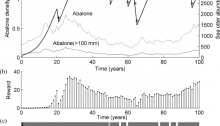And the answer is no, but poaching is.
I’ve recently been contacted to talk about our paper in Conservation Biology (v.26/6), that forced me to read again our paper and assess what information was really valuable in this study. I thought that Jessica Jonhson – science writer for The Wildlife Society’s magazine The Wildlife Professional – did a great job at explaining our findings:
Recovery targets for endangered species often ignore interactions between species. For ones that are tightly linked in a predator-prey relationship—such as the northern sea otter (Enhydra lutris kenyoni) and the northern abalone (Haliotis kamtschatkana), both endangered— management plans that focus on only one species can sometimes put the other at risk of extinction. As reported in Conservation Biology (v.26/6), Iadine Chadès of CSIRO Ecosystem Sciences in Australia and colleagues with Fisheries and Oceans Canada developed a computer model to predict the outcome of proposed recovery strategies that address both sea otters and abalone at once. To make its predictions, the model incorporates the population dynamics of each species, their interactions, and how management decisions affect their abundance. For example, sea otter populations are recovering well, and abalone could be in danger of overpredation by sea otters. However, the model revealed that even if sea otter predation somehow ceased, the abalone populations would not rebound. Instead, the model identified poaching of abalone as the most significant threat to that species, and calculated that poaching would have to be cut in half in order for populations to grow again. Such models cannot guarantee that a management action will succeed, but can help managers make more informed decisions when complex species interactions are involved.
Thanks Jessica,
Chadès, I., Curtis, J.M.R., and Martin, T.G., 2012. Setting realistic recovery targets for interacting endangered species. Conservation Biology 26, 1016-1025. (PDF)
